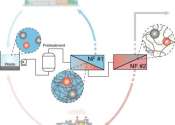Earth is the third planet from the Sun, and the largest of the terrestrial planets in the Solar System in terms of diameter, mass and density. It is also referred to as the World, the Blue Planet, and Terra.
Home to millions of species, including humans, Earth is the only place in the universe where life is known to exist. The planet formed 4.54 billion years ago, and life appeared on its surface within a billion years. Since then, Earth's biosphere has significantly altered the atmosphere and other abiotic conditions on the planet, enabling the proliferation of aerobic organisms as well as the formation of the ozone layer which, together with Earth's magnetic field, blocks harmful radiation, permitting life on land. The physical properties of the Earth, as well as its geological history and orbit, allowed life to persist during this period. The world is expected to continue supporting life for another 1.5 billion years, after which the rising luminosity of the Sun will eliminate the biosphere.
Earth's outer surface is divided into several rigid segments, or tectonic plates, that gradually migrate across the surface over periods of many millions of years. About 71% of the surface is covered with salt-water oceans, the remainder consisting of continents and islands; liquid water, necessary for all known life, is not known to exist on any other planet's surface. Earth's interior remains active, with a thick layer of relatively solid mantle, a liquid outer core that generates a magnetic field, and a solid iron inner core.
Earth interacts with other objects in outer space, including the Sun and the Moon. At present, Earth orbits the Sun once for every roughly 366.26 times it rotates about its axis. This length of time is a sidereal year, which is equal to 365.26 solar days. The Earth's axis of rotation is tilted 23.4° away from the perpendicular to its orbital plane, producing seasonal variations on the planet's surface with a period of one tropical year (365.24 solar days). Earth's only known natural satellite, the Moon, which began orbiting it about 4.53 billion years ago, provides ocean tides, stabilizes the axial tilt and gradually slows the planet's rotation. Between approximately 4.1 and 3.8 billion years ago, asteroid impacts during the Late Heavy Bombardment caused significant changes to the surface environment.
Both the mineral resources of the planet, as well as the products of the biosphere, contribute resources that are used to support a global human population. The inhabitants are grouped into about 200 independent sovereign states, which interact through diplomacy, travel, trade and military action. Human cultures have developed many views of the planet, including personification as a deity, a belief in a flat Earth or in Earth being the center of the universe, and a modern perspective of the world as an integrated environment that requires stewardship.









